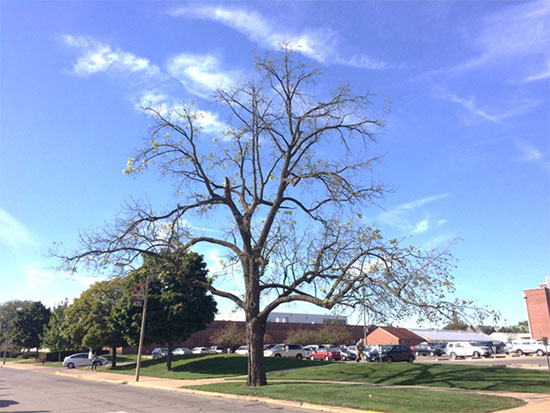Issue 17, September 28, 2015
Walnut Anthracnose
There are a number of potential causes for the premature defoliation of black walnut. Abiotic stress may cause black walnuts grown on poor sites, or those subjected to drought, to defoliate by August or September. These trees usually exhibit symptoms of scorch along the leaf margins, but lack symptoms and signs of common fungal leaf diseases. Several fungal pathogens are known to black walnut foliage, the most common being walnut anthracnose, caused by Gnomonia leptostyla (imperfect stage Marssonina juglandis).

Black Walnut defoliated by environmental stress and walnut anthracnose.
Walnut anthracnose symptoms are first observed on the undersides of the leaves as brown, small, circular lesions. These lesions eventually become visible on both sides of the leaves and range in size from tiny pinpoints up to 5 mm in diameter. Yellowing leaves, marginal browning, and casting of leaflets is commonly observed during the later stages of infection. In wet seasons, infected walnut tress may defoliate by late July or August. In addition to infecting the leaves, this fungus may also infect petioles, rachises, twigs, and fruit.
The walnut anthracnose fungus primarily overwinters in fallen leaves but may also survive in infected fruit and twig lesions. During favorable weather conditions in the spring, spores germinate and are disseminated to new foliage by wind and rain. With ample moisture, germinated spores infect the new leaves.
This disease is not associated with long-term harm to trees grown in the residential landscape. In general, most of the trees defoliated by this disease have already completed their required annual growth. Trees defoliated by anthracnose for one or two years are not usually damaged enough to noticeably affect growth. Trees affected for several successive years, however, may be stunted in growth and weakened. Several fungicides are labeled for control of walnut anthracnose. However, chemical controls are rarely warranted or cost effective. Instead, rake and remove of infected leaves and fruit to reduce future infections. Proper soil fertility has also been shown to boost tree vigor and reduce disease severity. (Travis Cleveland)
Author:
Travis Cleveland